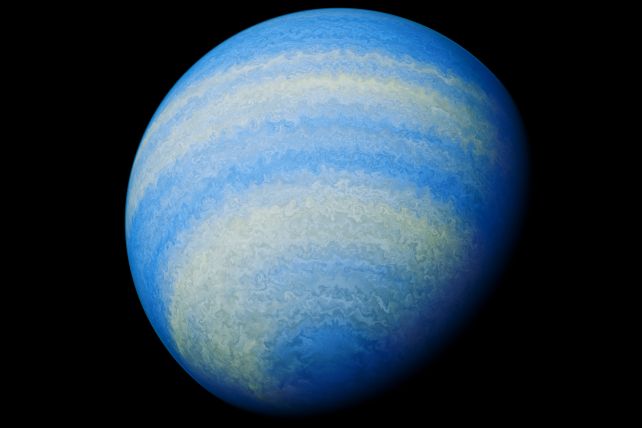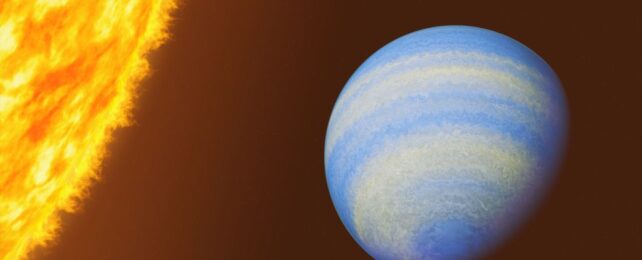Uranus, in what is perhaps one of the most beautifully apt coincidences in the galaxy, smells like a giant release of flatus. The penultimate planet of the Solar System is loaded with hydrogen sulfide, the gas that gives rotten eggs their distinctive aroma.
And now we've found the same stench elsewhere in the Milky Way. On one of the most extreme exoplanets in the galaxy, JWST had identified the signature of hydrogen sulfide.
The exoplanet is a scorching Jupiter-sized world named HD-189733b, and the literal stink lines detected in its atmosphere could help us better understand the role sulfur plays on worlds outside the Solar System.
"Hydrogen sulfide is a major molecule that we didn't know was there. We predicted it would be, and we know it's in Jupiter, but we hadn't really detected it outside the Solar System," says astrophysicist Guangwei Fu of Johns Hopkins University.
"We're not looking for life on this planet because it's way too hot, but finding hydrogen sulfide is a stepping stone for finding this molecule on other planets and gaining more understanding of how different types of planets form."
We've come a long way since the detection of the first exoplanet back in the early 1990s. Now, we know of thousands, and have the tools to discover their properties. One of those tools is the way the light from a host star changes when the exoplanet passes between it and us, a passage known as a transit.
This causes the light of the star to dim a little. It's a very small signal, but we have the tools now to identify it with certainty. But as the light of the star filters through the atmosphere of the exoplanet around the edge of the disk, it can be altered by the molecules therein.
Certain wavelengths of light are absorbed by different molecules, and re-emitted at a different wavelength. These are known as absorption and emission lines on a spectrum of light, and each molecule has its own pattern that signals its presence.
HD-189733b, discovered in 2005, is a type of world known as a hot Jupiter located just 64.5 light-years from Earth. It's a gas giant on an extremely close orbit with its host star, whipping round once every 2.2 days or so. At that proximity, the heat of the star scorches the exoplanet, raising its temperature to thousands of degrees.
Because we've known about it for so long, and because it's so close, HD-189733b is pretty well studied. We know it has a thick atmosphere, and powerful winds faster than anything seen in the Solar System. Previous research has even identified certain elements in the exoplanet's atmosphere.

But JWST is way more powerful than any telescope that has looked at HD-189733b to date. And these strange hot Jupiters could tell us a lot about planetary formation and evolution. As the closest hot Jupiter to Earth, HD-189733b was too good an observation opportunity to pass up – especially since some detections have been ambiguous.
Now, Fu and his colleagues have narrowed down the list of potential molecules in the planet's atmosphere. In addition to hydrogen sulfide, the team found water, carbon dioxide, and carbon monoxide. These four molecules are the biggest reservoirs for oxygen, carbon, and sulfur in the atmosphere of HD-189733b.
They also found no sign of methane, a molecule that had appeared in one set of measurements, but was not found in another. This suggests that there is no methane present – which is perfectly in line with what the team expected to find in a hot Jupiter, which is way too hot for large concentrations of methane to form.
They also studied the metallicity of the atmosphere, the concentration of elements heavier than hydrogen and helium. They found the world's metallicity was 3-5 times higher than that of its host star – a discovery that reveals something about how the exoplanet formed.
"This Jupiter-mass planet is very close to Earth and has been very well studied. Now we have this new measurement to show that indeed the metal concentrations it has provide a very important anchor point to this study of how a planet's composition varies with its mass and radius," Fu says.
"The findings support our understanding of how planets form through creating more solid material after initial core formation and then are naturally enhanced with heavy metals."
The next step, the team says, is to search for signs of sulfur on other hot Jupiters. These worlds are thought to be too close to their stars to have formed there, which suggests that they may have formed farther out, and migrated inwards. If sulfur is a common feature in hot Jupiters, it may reveal something about how they formed, and where.
And, of course, all that stench gives us one more reason not to go visit in person.
The research has been published in Nature Astronomy.
